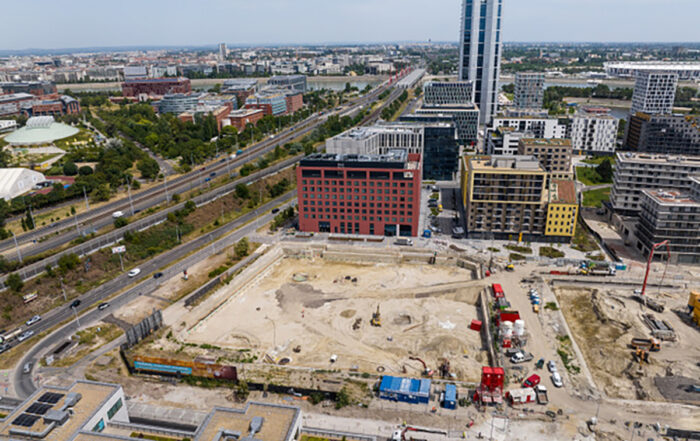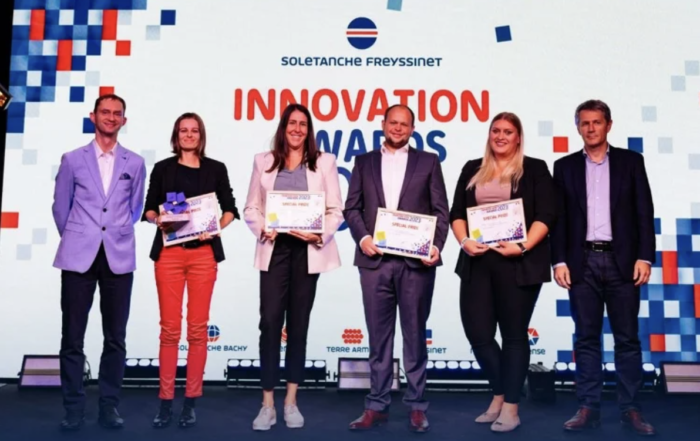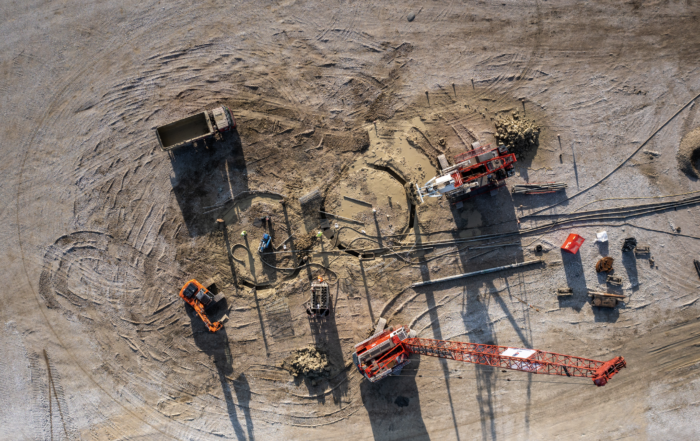In civil engineering, majority of the carbon dioxide emission is related to concrete production, which is why HBM primarily focuses on reducing this for the sake of sustainability.
From a sustainability point of view, the construction industry has major responsibility: this industry is responsible for about a third of the world’s carbon dioxide emissions. Therefore, HBM, the Hungarian subsidiary of the French company Soletanche Bachy, dealing with special civil engineering tasks, primarily deep foundation works and encircling of underground spaces, decided to follow the climate protection goals of the European Union and its mother company:
By 2030, it will reduce the carbon footprint of its construction works by 40 percent while also striving to use construction materials with the lowest possible carbon emission in all its projects.
The foundation structures designed and built by HBM are made underground, and the result is rarely visible, but many people have already met the solutions of the company with more than 25 years of experience in the Hungarian market. HBM built the foundations of the Mercedes factory in Kecskemét, the valley bridge of Kőröshegy, and Puskás Stadium, but they also worked on the reconstruction of Chain Bridge, the foundation of six other Danube bridges, five metro stations, and the renovation of tram line 1 in Budapest.
CARBON EMISSION MONITORING
From the list above, it can be seen that they are present in most sectors of the construction industry, and although they deal with many different types of structures, they can do something for sustainability in each of them. “Speaking of emission reduction, it is also true that we can change only what we measure. We can assign goals to what we can measure. Afterward, we can dedicate different actions to these goals. HBM is definitely cutting edge in the sense that we have already incorporated these data and information into our daily practice, we constantly measure the CO2 emission of both our construction works and our technical solutions, and according to our plan, we will soon include this in our price offers too – elaborated István Stötzer, the managing director of HBM appointed in September, who previously worked as a purchasing director at the company. In addition to industry-standard solutions for measurements, monitoring, and calculations, the company group also developed its own software.
ECO-CONSCIOUS DESIGN
“More than 60 percent of the CO2 footprint of the special civil engineering segment is accounted for concrete and cement that ensures the concrete’s strength,” explained István Stötzer. The chemical process of cement production, as well as the energy generation required for production, also produces carbon dioxide, which is why the company group started to focus specifically on concrete. First of all, they aim to use as few raw materials as possible: this is supported by decades of experience and the fact that they work with this goal in mind already during the design phase. “Our design team tries to develop technical solutions and methods that will make our foundation structures shorter, slimmer, and use less material,” said István Stötzer. This demand also arises from the customers, since using fewer materials is not only important from an environmental protection point of view but also means cost reduction. The other direction is the optimization of the built-in materials. Although cement makes up only 15 percent of the weight of concrete, it is responsible for 80-85 percent of its CO2 emission, thus it is important what recipe a company uses. HBM, therefore, works with partners who are at the forefront of emission reduction and efficiency optimization. In cooperation with the relevant manufacturers, based on research and tests carried out by the company group, a special, ultra-low carbon dioxide-emitting concrete mix, EXEGY, was created using various additives. “In Eastern Hungary, there were already investments in the first half of the year where the investor had a definitive request that the CO2 footprint of the technical and foundation solutions used by HBM has to be minimized, here we have already used EXEGY,” added István Stötzer. After gaining more and more experience, they began to use these mixtures even in investments where it wasn’t requested by the investor per se.
„About 30 percent of the concrete built in by our company this year has a low carbon footprint. For the time being, we are progressing in this field even without specific customer requests, so that we can achieve our set long-term goals. We want to reach over 90 percent by the end of the decade. We have a great chance to accomplish that.”
GREEN ENERGY AND RECYCLING
Currently, however, this special concrete cannot be used without making compromises: higher strength or waterproofing requirements or the availability of suppliers in the vicinity of the project site may be a limitation. “But this is also just a matter of time, probably by the end of the decade we will be able to offer an alternative solution from the EXEGY concrete palette for every technical and structural requirement,” said István Stötzer.
In addition to material reduction and the new concrete formula, there are other solutions that a construction company can apply to become greener. HBM, for example, has set itself the goal of replacing its existing car fleet with hybrid or fully electric cars soon, while they are also dealing with their equipment: on the one hand, they are modernizing, the newer machines with lower fuel consumption emit significantly fewer pollutants than the older ones, while on the other hand, they are also looking for hybrid solutions. Furthermore, they are negotiating with partners who can go green in transportation, trying to replace traditional trucks with hybrid or electric vehicles as much as possible. “This is more of a medium or long-term process. For this to happen, it is necessary to further develop the infrastructure, the road network, and the EV charging network. It is not enough to just modernize the machinery itself,” explained István Stötzer.
HBM is also aiming to improve its waste management solutions. This stands true for its offices, where there is also an educational perspective in selectively managing the waste, but they are using digital solutions wherever it’s possible, to reduce the amount of paper used in the first place. The civil engineer also strives to achieve similar results on its sites by reusing part of the already produced waste and reducing the amount of waste – as it is now a clear expectation from investors in several projects. “We have numerous projects where the proportion of waste recycling needs to be brought above 70 percent. We use a lot of concrete, but our concrete waste can be reused with certain technologies, grinding and cleaning, these materials can be re-integrated, and thus the environmental impact can be reduced.”
But in the construction industry, it can be just as important to reinterpret existing products and technical solutions on sites. “Recently, we had a project where the investor aimed to reuse and recalculate an existing foundation model. Instead of creating new foundations, we revised the existing foundations. This is still a very rare example in special civil engineering in our country, but it also promotes a kind of sustainable state, where we are not talking about building something new, but about how to renovate and transform an existing structure so that it can fulfill a new function.” said István Stötzer.
Source: Forbes





